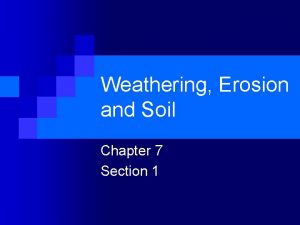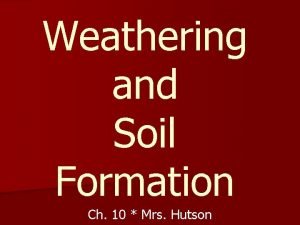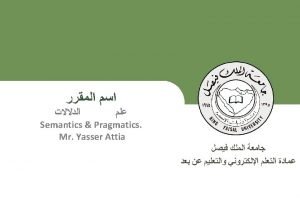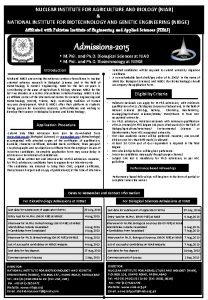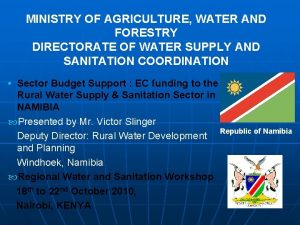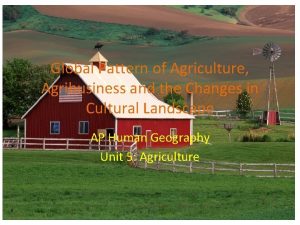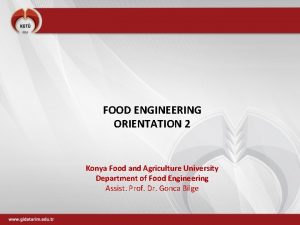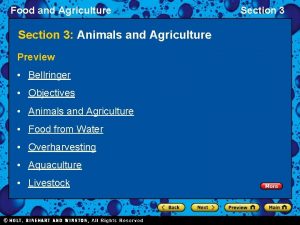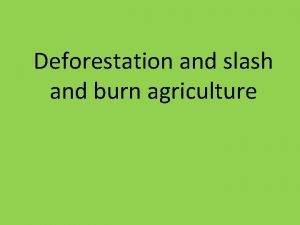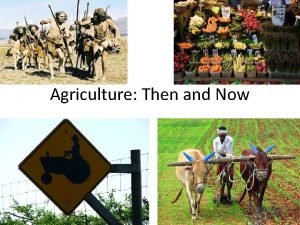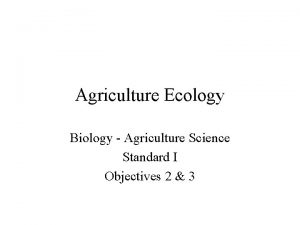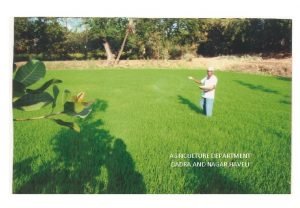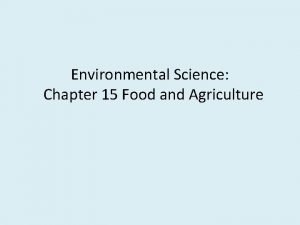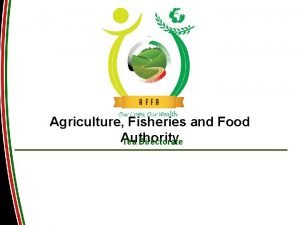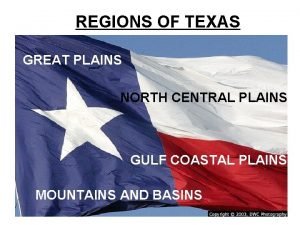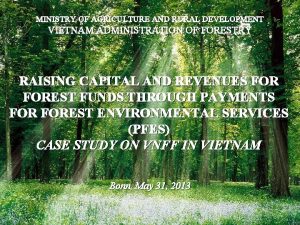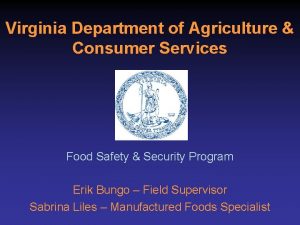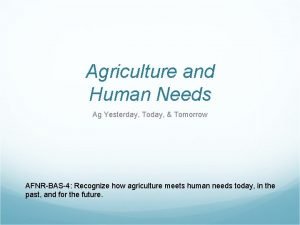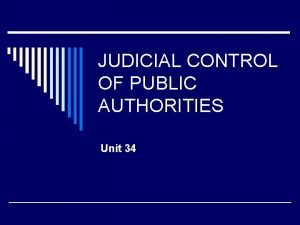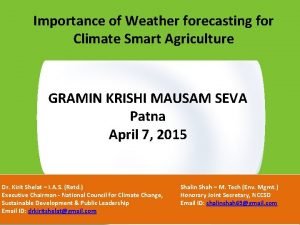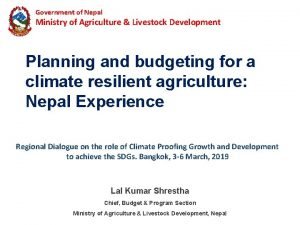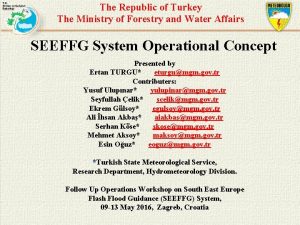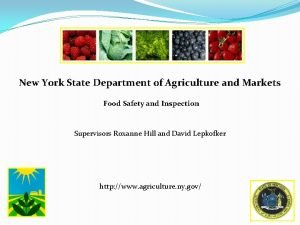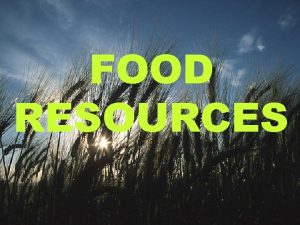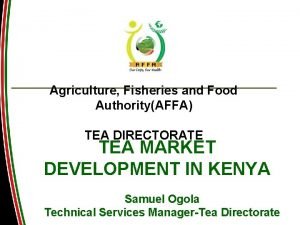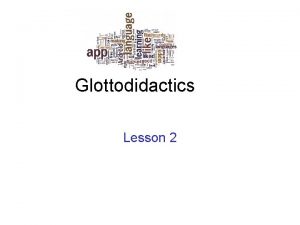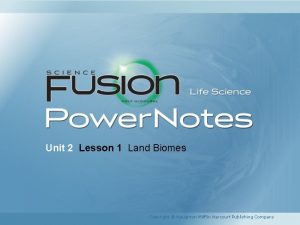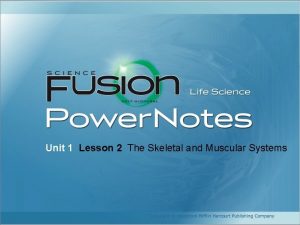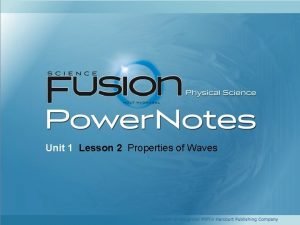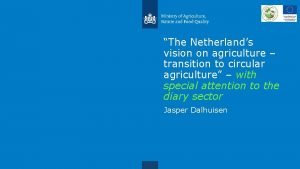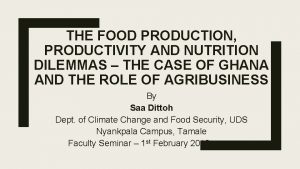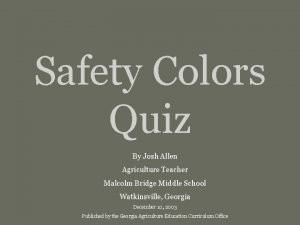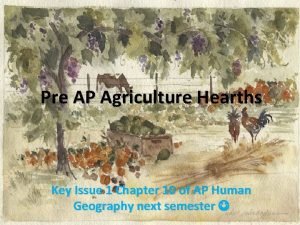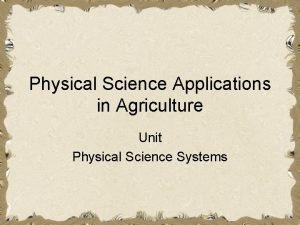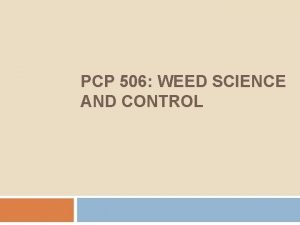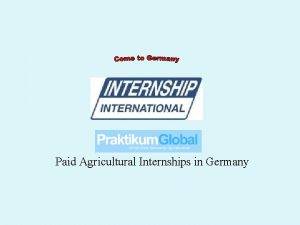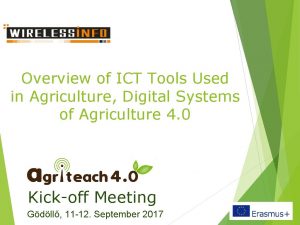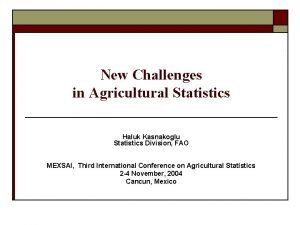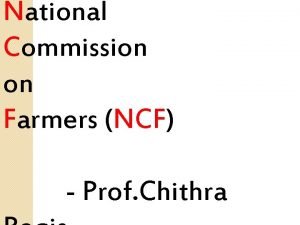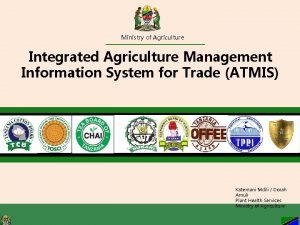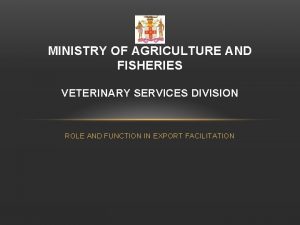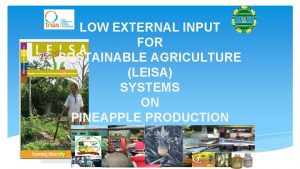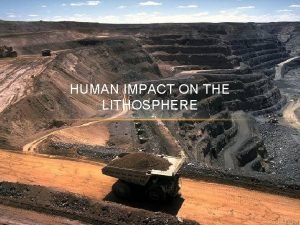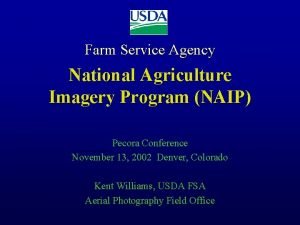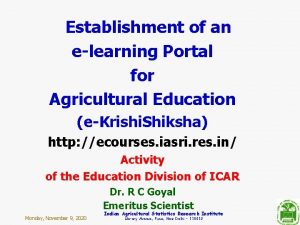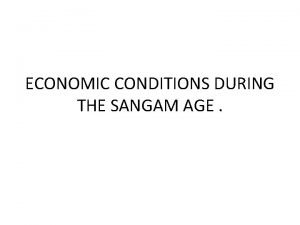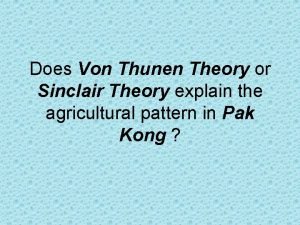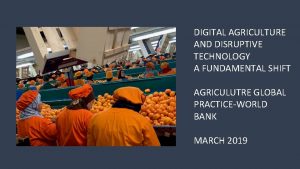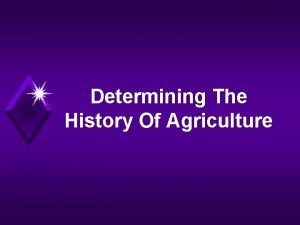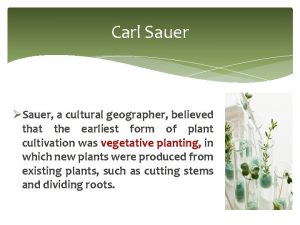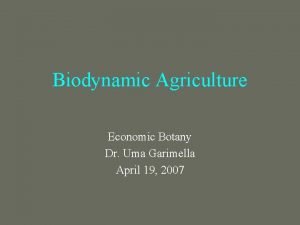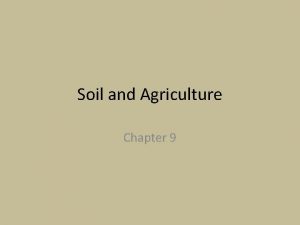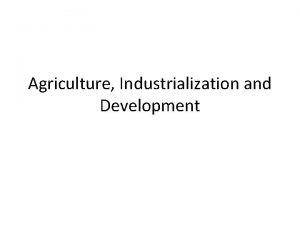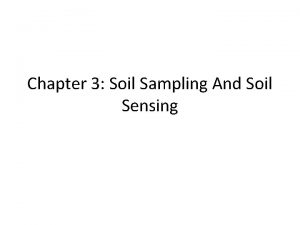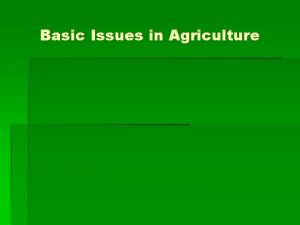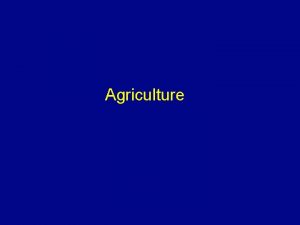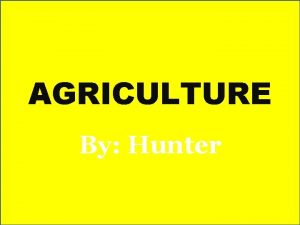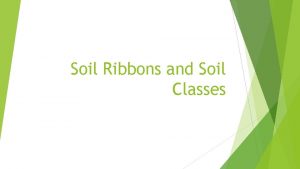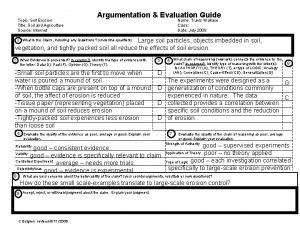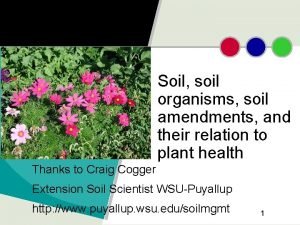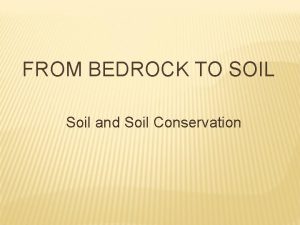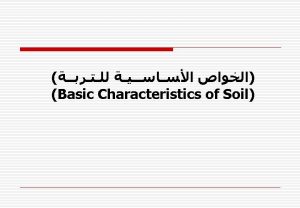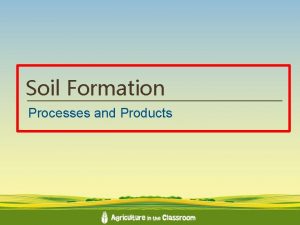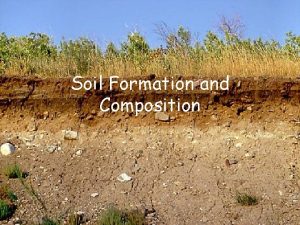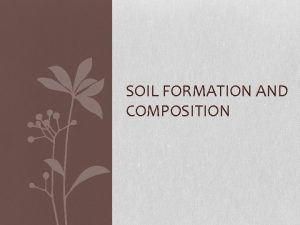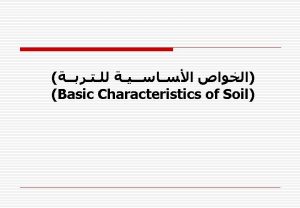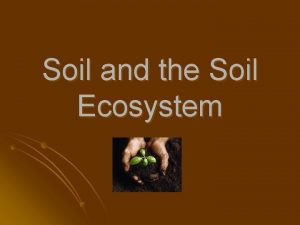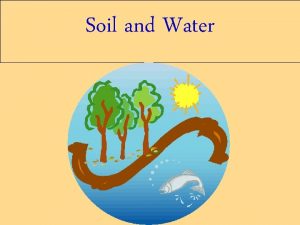Chapter 12 Soil and Agriculture Lesson 1 Soil

























































































- Slides: 89

Chapter 12: Soil and Agriculture

Lesson 1: Soil

—Soil is a complex plant-supporting system made up of disintegrated rock, remains and wastes of organisms, water, gases, nutrients, and microorganisms. o Several factors influence soil formation including climate, organisms, landforms, parent material, and time. o Considered a renewable resource, can replenish itself, but may take a very long time to form

—Soil Formation o Soil is a complex substance that forms through weather, deposition, and decomposition. o Soil consists of roughly 45% mineral matter and 5% organic matter § Mineral matter = tiny rock particles § Organic matter = decomposing organisms, and living microorganisms

o Parent material is the base geological material in a particular location § Ex: volcanic ash, sediments deposited by rivers, or bedrock o Bedrock is the continuous mass of solid rock that makes up Earth’s crust

o Weathering § Describes the physical and chemical processes that break down rocks and minerals into smaller particles. § Physical weathering is the natural breakup of rock without a chemical change • Ex: wind and rain § Chemical weathering occurs when water and other substances chemically break down parent material and rocks transforming them into different materials.

o Deposition § Deposition is the drop-off of eroded material at a new location § Erosion may help form soil in one area by depositing material eroded from another.

o Decomposition § As plants, animals, and microorganisms deposit waste or die and decompose, nutrients are incorporated into the soil § Leaf litter – dead leaves and other vegetation – is broken down by decomposers and detritivores § Humus is partially decomposed organic matter that is a dark, spongy, crumbly mass of material made up of complex organic compounds. • Holds moisture well • Contains many plant nutrients

—Soil Horizons o A soil profile consists of layers known as horizons. o When soil is formed, wind, water, and organisms move the particles and eventually the soil becomes sorted into distinct layers known as soil horizons. o A cross-section of all the soil horizons in a specific soil, from surface to bedrock, is known as a soil profile.

o Soils from different locations vary, and few soil profiles contain all six horizons, but every soil contains at least some of them. o The six major soil horizons are the O, A, E, B, C, and R horizons.

§ O horizon • The litter layer • Consists mostly of organic matter • Humus present here • Many organisms live in this horizon

§ A horizon • The topsoil layer • Consists mostly of mineral particles such as weathered parent material mixed with organic matter and humus from the O horizon • Loose texture • Dark color • Good ability to hold water • Has the most plant nutrients available • Many organisms live in this horizon

§ E horizon • The leaching layer • Leaching = the process whereby solid particles suspended or dissolved in liquid are transported to another location • Minerals and organic matter tend to leach out of this horizon • Minerals that are resistant to leaching are left behind • Less organic matter than the A horizon • Typically pale soil

§ B horizon • The subsoil layer • Minerals leached from the E horizon accumulate here • Often reddish or yellow in color • Typically high in clay concentration

§ C horizon • The weathered parent material layer • Parent material is unaltered or only slightly altered by the process of soil formation § R horizon • The parent material layer • Parent mineral material originally occupying the site

—Soil Characteristics o Soils can be classified by their color, texture, structure, and p. H. o The color of a soil reveals details about its composition and fertility § Dark soils are usually rich in humus and therefore nutrients § Pale soils often have less humus and nutrients

o Soil texture is based on particle size § Clay consists of particles less than 0. 002 millimeter in diameter • Particles adhere easily to one another § Silt consists of particles 0. 002 -0. 05 millimeter in diameter § Sand consists mostly of particles 0. 05 to 2 millimeters in diameter • Particles do not adhere to one another

§ Soil with a relatively even mixture of the three particle sizes is known as loam.

§ Influences a soil’s workability – how easy it is to plant in and harvest from § Indicates how porous a soil is – the size of the spaces between its particles • Finer particles = smaller spaces (harder for air a water to travel through) • Larger particles = larger spaces

o Soil structure describes the arrangement of soil particles – seen in the “clumpiness” of soil § Large and densely compacted soil can prevent plant roots from growing

o A soil’s acidity or alkalinity affects its ability to support plant growth § Different plants requires different p. H levels § Soil p. H varies naturally § Acid precipitation and leaching of minerals from the soil can affect the p. H

Lesson 2: Soil Degradation and Conservation

—The most productive soil – type of soil most plants grow best in – is loam with a neutral p. H that is workable, contains nutrients, and holds water. —The deterioration of the soil characteristics needed for plant growth or other ecosystem services is called soil degradation.

—Erosion o Certain farming, ranching, and forestry practices can erode soil, but other practices can protect it. o Erosion and deposition are natural processes that can help create soil over time. o Erosion can be a problem because it usually occurs much more quickly than soil is formed.

o Today, human activities cause more erosion than natural events. § Leaving soil bare after harvests § Overgrazing rangelands § Clearing forests on steep slopes or with large clear-cuts o Plant communities protect soil from erosion by slowing wind and water, holding soil in place with their roots, and absorbing water.

o Soil Conservation Techniques § Intercropping is the planting of different crops in mixed arrangements • Provides more plant cover • Reduces a field’s vulnerability to insects and disease that specialize in certain crops

§ In crop rotation farmers alternate crops grown in a field • Returns nutrients to the soil • Breaks disease and pest cycles • Prevent erosion that can come from letting fields lie fallow • Cover crops help prevent erosion and often limit nitrogen loss, because they are often nitrogenfixing crops

§ Shelterbelts (windbreaks) are rows of trees or other tall perennial plants that are planted along the edges of fields to slow the wind • Reduces wind erosion

§ Tilling is the turning-over of soil before planting • Creates more pores for air and water • Makes soil more susceptible to erosion § To plant using the no-till method, a tractor pulls a drill that cuts furrows through weeds and crop remains and into the topsoil. Seeds are then dropped into the furrows and then the furrows are closed. • Reduced-tillage agriculture disturbs the soil surface slightly more than no-till does • Requires use of weed-killers and fertilizers

§ Terracing transforms steep slopes into a series of steps like a staircase • Minimizes erosion on steep hillsides • Labor-intensive

§ Contour farming consists of plowing sideways across a hillside, perpendicular to the hill’s slope • Reduces erosion • Furrows act as a dam that catches soil before it is carried away

o Ranching Practices § Livestock are animals raised to be used on a farm or sold at a profit § When too many animals eat too much of the plant cover, impeding growth, the result is overgrazing • Exposes more soil to erosion • Non-native weedy plants may invade exposed soil § Range managers assess the carrying capacity of rangelands, and establish and enforce grazing limits on publically owned lands.

—Forestry practices have been altered over the years to try to minimize damage to soils.

—Desertification o Desertification reduces productivity of arid lands o Desertification is a loss of more than 10 % of productivity due to erosion, soil compaction, forest removal, overgrazing, drought, salt buildup, climate change, depletion of water resources, and other factors. o Severe desertification can enlarge existing deserts and create new ones in once-fertile regions o Arid and semiarid lands are prone to desertification because they get too little precipitation to meet growing humans demands for water

o Global Desertification § Desertification affects one third of Earth’s land area § Soil degradation forces ranchers to crowd their animals onto less-productive land farmers to keep planting in poor soils, both worsen desertification

o The Dust Bowl § Between 1879 and 1929 settlers farmed and ranched on the Great Plains, contributing to erosion by removing the grasses that had conserved the soil and by breaking down the soil structure. § In the early 1930 s a drought occurred, aggravating the erosion and the region’s strong winds began to erode millions of topsoil. § The most-affected region became known as the Dust Bowl

— Soil Conservation Policies o U. S. and international agricultural organizations promote soil conservation o In 1935, the U. S. Congress passed the Soil Conservation Act, establishing the Soil Conservation Service (SCS). § Worked with farmers to develop conservation plans § SCS renamed the Natural Resources Conservation in 1994 § Responsibilities also include water quality protection and pollution control

o The Conservation Reserve Program (CRP), established in the 1985 farm bill, pays farmers to stop cultivating cropland that erodes easily and to instead place it in conservation reserves planted with grasses and trees § Reduces erosion § Generates income for farmers § Improves water quality § Provides habitat for wildlife

o The United Nations promotes soil conservation and sustainable agriculture through its Food and Agriculture Organization (FAO) § Farm-Centered Agricultural Resource Management (FARM) supports creative approaches to resource management challenges in many developing nations.

—Soil Pollution o Irrigation and pesticide use can improve soil productivity in the short term, but they can pollute soil in the long term. o The providing of water other than precipitation to crops is known as irrigation. § Too much, or carelessly timed irrigation can result in waterlogged crops

§ In dry areas where precipitation is minimal and evaporation rates are high, water evaporating from the soil’s A horizon may pull up water which carries dissolved salts from lower horizons. When that water evaporates, the salts remain. § Salinization is the buildup of salts in upper soil horizons • Decreases harvests on 20% of all irrigated cropland worldwide

§ Salinization Solutions: • Avoid planting crops that require a great deal of water in dry areas. o The best option • Irrigate with water that is low in salt content • Irrigate efficiently – supplying no more water than the crop requires and supplying it as close to the roots as possible. o Ex: drip irrigation

o Chemicals that kill organisms that attack or compete with plants we value are called pesticides. § Kill plant, animal, fungal, bacterial, or viral pests o Chemicals that kill other plants are sometimes called herbicides o Can be hazardous to humans and other animals in the long term when they filter into groundwater or evaporate into the air. o Broad-spectrum pesticides kill a wide variety of insects, even those that are helpful to soil, and can be hazardous to soil health.

Lesson 3: Agriculture

— Development of Agriculture o Agriculture began about 10, 000 years ago, when warmer climate enabled humans to plant seeds and raise livestock. o Agriculture probably began when hunter-gatherers brought wild fruits, grains, and nuts back to their camps and seeds were accidentally planted. o Eventually, people realized they could control what they grew and began planting seeds only from those plants whose fruit they liked the most. § Artificial selection/selective breeding

o Once our ancestors learned to cultivate crops, they began to build more permanent settlements. § Near water sources § Planted more crops § Raised animals as livestock

o Eventually, the ability to grow excess food enabled some people to live away from the farm o Traditional agriculture is a type of farming that relies on human and animal power, along with hand tools and non-motorized machines

—Industrial Agriculture o Industrial agriculture and the green revolution have saved millions of people from starvation. o The Industrial Revolution introduced largescale mechanization and fossil-fuel engines to agriculture – more efficient means of harvesting, processing, and transporting crops. § Irrigation improved § Synthetic fertilizers and chemical pesticides were introduced

o Because the soil was more productive, and fewer crops were lost to pests, yield increased § Yield is the amount of a crop produced in a given area. o Industrial agriculture is a type of farming that relies on technology and chemicals to increase yields and reduce costs, also known as highinput agriculture. § Uses large machinery and chemicals that are customized for a specific crop, therefore to be most efficient farmers plant large areas with a single crop (monoculture). § Large monocultures reduce biodiversity and are more vulnerable to diseases and pests

o The Green Revolution § In the mid- to late 1900 s, the desire for more and better food for the world’s growing population led to the green revolution, in which agricultural scientists from developed nations introduced new technology, crop varieties, and farming practices to the developing world. § In the 1940 s, Norman Borlaug introduced Mexico’s farmers to a specially bred strain of wheat that produced large seed heads, was short enough to avoid wind damage, resisted diseases, and produced high yields. § Along with new strains of crops, developing nations also imported new methods of industrial agriculture from developed nations

§ Positive Effects • Higher productivity of already cultivated land preserved some ecosystems • Food production rose 150% • Prevented some deforestation and habitat loss • Preserved the biodiversity of some ecosystems

§ Negative Effects • 1900 -2008 energy used by agriculture increased by 7, 000% • Worsened erosion, salinization, desertification, eutrophication, and pollution • Increased air pollution • Contributed to global warming

—Pests o Chemical pesticides, biological pest control, and integrated pest management can all effectively protect crops from pests. o An organism is a pest when it damages plants that are valuable to us. o A plant is a weed when it competes with plants that are valuable to us.

o To prevent crop losses from pests and weeds, people have developed thousands of chemical pesticides. § The ability of a pesticide to reduce a pest population often declines over time as the population evolves resistance to it.

o Due to pesticide resistance and health risks from some pesticides, agricultural scientists increasingly battle pests and weeds with organisms that eat or infect them – biological pest control § A widespread modern biological pest control effort is the use of Bacillus thuringiensis (Bt) – a naturally occurring soil bacterium that produces a protein that kills many caterpillars and the larvae of some flies and beetles. § Introducing predators or parasites from a different ecosystem • Has resulted in some invasive species

§ Can be a permanent solution that requires no maintenance and is environmentally harmless § If nontarget organisms are harmed, the damage may be permanent § Halting biological pest control is far more difficult than stopping the application of pesticide

o Integrated Pest Management (IPM) combines different techniques to achieve the most effective long-term pest reduction § May include biological pest control, close monitoring of populations, habitat alteration, crop rotation, reduced soil tillage, mechanical pest removal, and chemical pesticides.

—Pollinators o Insects and other animals are essential to the reproduction of many crops. o Pollination is the process by which male sex cells of a plant (pollen) fertilize female sex cells of a plant. o Pollinators are animals that transfer pollen from one plant to another

o Our important grain crops, such as corn and wheat, are wind-pollinated, but many other crops, such as fruits depend on insects for pollination. o Many pollinator populations have declined § Ex: alkali bee, honeybee

Lesson 4: Food Production

—Food Security o Because hunger continues and the population is growing, we need to find a way to increase food production sustainably o Arable land = land suitable for farming o Since 1961 our ability to produce food has grown faster than the human population, but the world’s soils are in decline and nearly all of the planet’s arable land is already being farmed.

o Despite the rise in food production, 1 billion people are still hungry o Food security is the guarantee of an adequate and reliable food source for all people at all times § Making the food supply secure depends on maintaining healthy soil and water, protecting the biodiversity of food sources, and ensuring the safe distribution of food.

o People who are undernourished receive less than 90% of their daily caloric needs § Most live in developing countries § Usually due to economic reasons

o Both the quantity of food a person eats and the quality of food a person eats are important for health o Malnutrition is a shortage of nutrients the body needs § Occurs when a person fails to obtain a healthy variety or quantity of nutrients § Can lead to disease

—Genetically Modified Organisms o Genetically modified food is a promising way to increase food production, but there needs to be more research into potential risks. o Any process in which scientists directly manipulate an organism’s DNA is called genetic engineering.

o Organisms that have undergone genetic engineering are often called genetically modified (GM) organisms. § Recombinant DNA technology is a technique in which DNA is taken from multiple organisms and pieced together – placing genes that code for desired traits into organisms that lack those traits (ex: rapid growth)

“anti-freeze genes” found in cold water fish like Sea Flounder and Arctic Char + strawberry

o Biotechnology is the use of genetic engineering to introduce new genes into organisms to produce more valuable products o Many GM crops today are engineered to resist herbicides and/or insect attacks § Makes the plants more efficient and sometimes more economical; the US grows about half of the global total of GM crops

o Potential Risks § As many GM crops were adopted, research proceeded, and biotechnology expanded, many citizens, scientists, and policy-makers became concerned. § Fears that the new food might be dangerous for people to eat § Worried that pests would evolve resistance to the pest-resistant crops and become “superpests”

§ Concerned that GM genes might escape, pollinating non-GM plants and harming those organisms or others • Supported by evidence • Most scientists think GM genes will inevitably make their way from GM crops into wild plants • The consequences of this potential event is still being debated

§ Millions of people eat GM foods every day without obvious signs of harm, and evidence for the negative environmental effects is limited so far § GM technology is new and changing, therefore scientists are still learning about it and continue to research the effects

o Potential Benefits § Growing insect-resistant crops reduce the use of chemical insecticides § These crops reduce carbon emissions for two reasons: • If crops need fewer pesticide applications, then the equipment used to apply pesticides uses less fuel • If herbicide-resistant crops encourage the adoption of no-till farming, then more carbon remains in the soil and is not released into the atmosphere

o So far, GM crops have not lived up to their promise of feeding the world’s hungry o Crops with GM traits that might benefit poor small-scale farmers in developing nations – increased nutrients, drought tolerance, and salinity tolerance – have not been widely developed

—Industrial Food Production o Feedlots, aquaculture, and other methods of industrial food production are efficient, but they have disadvantages. o Raising plants and animals for food affects the environment no matter how it is done.

o Feedlots are large warehouses or pens designed to deliver energy-rich food to livestock or poultry. § Also known as concentrated animal feeding operations or factory farms

§ Advantages • Allow for a greater, more efficient production of food • Necessary for a nation with a high level of meat consumption (US) • Soil is not degraded from overgrazing • Reduce the need for chemical fertilizers because feedlot manure is often applied to farm fields as fertilizer.

§ Disadvantages • Improper management of feedlot manure can lead to illnesses in feedlot animals, humans, and other animals through the contamination of bodies of water. • Due to living conditions, feedlot animals need to be given heavy doses of antibiotics o Can make their way into people who eat animal products o May leech into groundwater o Likely that bacteria will develop resistance • The treatment of animals in feedlots is questionable

o Aquaculture is the raising of aquatic organisms for food in a controlled environment. § Also call fish farming § The fastest growing type of food production § Provides more than one third of the aquatic animals that are eaten by humans

§ Benefits • On small scale, ensures local people a reliable protein source • Can be sustainable • Reduces harvesting of declining aquatic animals • Reduces by-catch, the unintended death of non target animals • Uses less fossil fuels than fishing vessels do • Provides a safer work environment than commercial fishing does

§ Costs • Diseases spread easily through dense populations • Produces enormous amounts of waste that may pollute water • Escaped organisms may spread disease to wild animals • Escaped organisms may outcompete wild animals and threaten wild populations

o Plant Diversity: Monocultures § GM genes might move by pollination into wild relatives of crop plants, outcompete them, and force them into extinction resulting in a monoculture in the wild as well as on farms. • A single pest could destroy all of a crop – GM, conventional, and wild § We have already lost a great deal of genetic diversity in our crop plants due to the fact that market forces have discouraged diversity.

§ Protecting areas with high plant diversity is one way to preserve the genetic diversity of our crops. § Seed banks are organizations that preserve seeds of diverse plants as a kind of insurance policy against a global crop collapse.

o Energy Efficiency § Our food choices are also energy choices and determine how efficiently we use the sun’s energy. § It requires much more feed to produce a kilogram of meat than it does to produce a kilogram of eggs or milk.

—Sustainable Agriculture o Sustainable alternatives to industrial agriculture include organic agriculture and locally supported agriculture. o Sustainable agriculture is agriculture that does not deplete soil faster than it forms, reduce the amount or quality of soil, water, and genetic diversity essential to long-term crop and livestock production.

o Organic Agriculture § Sustainable agriculture that uses smaller amounts of pesticides, fertilizers, growth hormones, water, and fossil fuel energy is often called low-input agriculture. § Food growing practices that use no synthetic fertilizers, insecticides, fungicides, or herbicides – but instead rely on biological approaches such as composting and biological pest control – are called organic agriculture.

§ In 1990, Congress passed the Organic Food Production Act which established standards for organic products and the sale of organic food. § In 2000 the USDA issued criteria by which it would certify crops and livestock as organic.

§ Reasons consumers by organic products: • Concerned that produce grown with pesticides may pose health risks • Desire to protect air, water, and land • To protect nontarget organisms from pesticides and herbicides

§ Practiced in less than one percent of farmland worldwide, but is increasing • Start-up costs are high, but once established, organic farming can yield just as much income as conventional farming • Organic foods can sell for higher prices

o In developed nations, increasing numbers of consumers are supporting local, small-scale agriculture. o In an arrangement called communitysupported agriculture (CSA), consumers pay farmers in advance for a weekly share of their produce during the growing season.
 Living soil vs dead soil
Living soil vs dead soil What are the four spheres of the earth
What are the four spheres of the earth Chapter 1 lesson 1 your total health answer key
Chapter 1 lesson 1 your total health answer key Chapter 7 weathering erosion and soil
Chapter 7 weathering erosion and soil Venn diagram of chemical and mechanical weathering
Venn diagram of chemical and mechanical weathering Micro lesson ideas
Micro lesson ideas Sat vocabulary lesson 4
Sat vocabulary lesson 4 Lesson outline lesson 1 solids liquids and gases answer key
Lesson outline lesson 1 solids liquids and gases answer key Lesson 4 gravity and motion lesson review
Lesson 4 gravity and motion lesson review Scrap heap magnet diagram
Scrap heap magnet diagram The sun-earth-moon system worksheet answers lesson 1
The sun-earth-moon system worksheet answers lesson 1 Iron tools and agriculture
Iron tools and agriculture Demography antonym
Demography antonym Specialized stems examples
Specialized stems examples Nuclear institute for agriculture and biology
Nuclear institute for agriculture and biology Ministry of agriculture, water and forestry directorates
Ministry of agriculture, water and forestry directorates Cadastral system ap human geography
Cadastral system ap human geography Konya food and agriculture university
Konya food and agriculture university Section 3 animals and agriculture
Section 3 animals and agriculture Slash and burn definition
Slash and burn definition Agriculture now and then
Agriculture now and then Biology and agriculture
Biology and agriculture Agriculture in dadra and nagar haveli
Agriculture in dadra and nagar haveli Ministry of agriculture and rural development cameroon
Ministry of agriculture and rural development cameroon Florida dept of agriculture and consumer services
Florida dept of agriculture and consumer services Active reading animals and agriculture
Active reading animals and agriculture Tea directorate
Tea directorate Cities in the north central plains
Cities in the north central plains Where is america
Where is america Ecotourim
Ecotourim Mendel university fees
Mendel university fees Virginia department of agriculture and consumer services
Virginia department of agriculture and consumer services Agriculture cooperation and farmers welfare
Agriculture cooperation and farmers welfare Florida dept of agriculture and consumer services
Florida dept of agriculture and consumer services Florida dept of agriculture and consumer services
Florida dept of agriculture and consumer services Agriculture- yesterday today and tomorrow
Agriculture- yesterday today and tomorrow Ministry of food agriculture and fisheries denmark
Ministry of food agriculture and fisheries denmark Maine department of agriculture conservation and forestry
Maine department of agriculture conservation and forestry Allingham v minister of agriculture and fisheries
Allingham v minister of agriculture and fisheries Importance of weather and climate to agriculture
Importance of weather and climate to agriculture Ministry of agriculture and livestock development
Ministry of agriculture and livestock development Republic of turkey ministry of agriculture and forestry
Republic of turkey ministry of agriculture and forestry Nys department of agriculture and markets license
Nys department of agriculture and markets license Food resources world food problems
Food resources world food problems Agriculture and natural resources abbreviation
Agriculture and natural resources abbreviation Agriculture fisheries and food authority
Agriculture fisheries and food authority Lesson outline lesson 3 describing circuits answers
Lesson outline lesson 3 describing circuits answers Mountain building
Mountain building Lesson outline lesson 2 aquatic ecosystems answer key
Lesson outline lesson 2 aquatic ecosystems answer key Ihi l101
Ihi l101 Gift of chappals lesson plan
Gift of chappals lesson plan Lesson outline lesson 3 weather forecasts answer key
Lesson outline lesson 3 weather forecasts answer key Lesson 3 physical changes answer key
Lesson 3 physical changes answer key Climates of earth lesson 1 answer key
Climates of earth lesson 1 answer key Glottodidactics
Glottodidactics Lesson 2 measurement and scientific tools answer key
Lesson 2 measurement and scientific tools answer key Today lesson or today's lesson
Today lesson or today's lesson Unit 1 lesson 1
Unit 1 lesson 1 Lesson outline lesson 2 the muscular system answer key
Lesson outline lesson 2 the muscular system answer key Wave properties lesson 2
Wave properties lesson 2 Today's lesson or today lesson
Today's lesson or today lesson 1 important lesson that is worth sharing about this lesson
1 important lesson that is worth sharing about this lesson Today's lesson or today lesson
Today's lesson or today lesson Circular agriculture netherlands
Circular agriculture netherlands 10 importance of agriculture
10 importance of agriculture Heisa agriculture
Heisa agriculture Safety colors in agriculture
Safety colors in agriculture Carl sauer vegetative hearth theory
Carl sauer vegetative hearth theory Physical factors influencing agriculture
Physical factors influencing agriculture Allelospoly
Allelospoly Paid internships in germany
Paid internships in germany What are the ict tools used in agriculture
What are the ict tools used in agriculture 10 importance of agriculture
10 importance of agriculture Is the component of agriculture renewable action plan
Is the component of agriculture renewable action plan Mian nawaz sharif university multan
Mian nawaz sharif university multan Agricultural trade management information system
Agricultural trade management information system Veterinary services division
Veterinary services division High external input sustainable agriculture
High external input sustainable agriculture What is logframe in project
What is logframe in project Human impact on agriculture
Human impact on agriculture National agriculture imagery program
National agriculture imagery program Indian agricultural research institute
Indian agricultural research institute Physical factors influencing agriculture
Physical factors influencing agriculture During lecture
During lecture Sinclair theory
Sinclair theory Disruptive technology in agriculture
Disruptive technology in agriculture Learning objectives of agriculture
Learning objectives of agriculture Radioactive tracers in agriculture
Radioactive tracers in agriculture Carl sauer theory
Carl sauer theory Advantages of biodynamic agriculture
Advantages of biodynamic agriculture



